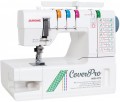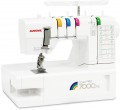Max. presser foot height
Distance from the working surface to the foot in the uppermost position. Must be taken into account when working with thick fabrics.
Sewing speed
The maximum sewing speed provided by the sewing machine. In the vast majority of models, this parameter can be adjusted, so if necessary, you can sew at a lower speed.
The more stitches a machine makes per minute, the higher its productivity, the better suited it is for large volumes of work. At the same time, it is worth considering that high speed has a corresponding impact on price and energy consumption, and it is not always required. Detailed recommendations on choosing the optimal speed for certain types of work can be found in special sources.
Features
—
Вышивание букв алфавита. Возможность вышивания букв алфавита с помощью машинки. Данная функция встречается в моделях с компьютерным управлением, она осуществляется за счет набора букв, занесенного в память машинки. Многие модели с такой возможностью имеют несколько встроенных шрифтов, а некоторые даже позволяют загружать свои шрифты с компьютера.
—
Дифференциальный транспортер. Транспортер для ткани, состоящий из двух зубчатых реек — перед и за иглой. В зависимости от выставленного режима такой транспортер может дополнительно растягивать или, наоборот, собирать ткань во время шитья; первое пригодится при работе с плотными тканями, второе — для трикотажа, стрейча и других легко тянущихся материалов.
—
Реверс. Функция, позволяющая переключать направление движения ткани под иглой и, соответственно, направление шва. Применяется в основном для закрепления строчки. Реверс является практически обязательным для швейных машин в классическом смысле слова — электромеханических, компьютеризированных и швейно-вышивальных (см. «Тип»), а вот в других типах практически не встречается.
— Рукавная платформа. Приспособление для работы с рукавами, штанинами и прочими аналогичными деталями одежды. Эта функция чаще всего реализуется за счет съемной части рабочего столика — при ее снятии столик превращается в узкую платформу. Конкретная ширина такого прис
...пособления может быть разной, ее стоит уточнять отдельно.
— Нитевдеватель. Специальное приспособление, предназначенное для того, чтобы облегчить процесс вдевания нитки в иголку. Наличие нитевдевателя особенно полезно при частной смене ниток (например, шитье попеременно разными цветами).
— Нитеобрезатель. Механизм для обрезания нитей после окончания шитья, избавляющий от необходимости использовать ножницы: для обрезания нитки достаточно нажать кнопку. Отметим, что речь идет именно об автоматическом нитеобрезателе; ручные приспособления, устанавливаемые на корпуса некоторых машинок, в данном случае нитеобрезателями не считаются.
— Шитье без педали. Возможность использовать машинку без подключения педали. Для запуска и остановки процесса в таких моделях, как правило, предусматривается специальная кнопка. Подобная возможность может пригодиться при длительном шитье, когда держать педаль постоянно нажатой было бы утомительно, и при эпизодическом использовании, когда машинка запускается «на пару стежков» и возиться с подключением педали особо незачем.
— Шитье двойной иглой. Возможность применения машинки для шитья двойной иглой — парой игл, закрепленных в одном держателе. Существуют разные виды таких игл и разные приемы работы с ними, а некоторые работы выполняются только двойной иглой. В любом случае для использования подобных приспособлений требуется, чтобы машинка была изначально с ними совместима.
— Позиционирование иглы (верх/низ). Переключатель, позволяющий пользователю выбрать, в каком положении будет находиться игла после остановки двигателя — верхнем или нижнем. При отсутствии такого выключателя игла, как правило, останавливается только в верхнем положении, а это не всегда удобноPresser foots
Виды лапок, поставляемых в комплекте со швейной машинкой.
— Универсальная. Лапка, используемая для стандартных швейных операций — преимущественно прямых строчек и зигзагов.
—
Лапка оверлочная. Лапка, предназначенная для выполнения оверлочной обработки. По определению встречается в устройствах с функцией оверлока (см. «Тип»), однако может предусматриваться и в традиционных швейных машинках. В последнем случае такая лапка, разумеется, не заменит полноценного оверлока, однако в некоторых ситуациях она позволяет обойтись без него.
—
Верхний транспортер ткани. Дополнительный транспортер для ткани, устанавливаемый сверху, вместо штатной лапки в дополнение к стандартному нижнему транспортеру. Такое приспособление облегчает работу с тонкими, деликатными и скользящими тканями, а также сшивание вместе нескольких слоев ткани: материал сдвигается максимально равномерно, без перекосов и смещений.
—
Лапка для вшивания молнии. Лапки для вшивания молнии могут иметь разный размер и конструкцию — в частности, существуют специальные приспособления для вшивания потайной молнии. Конкретные особенности данного приспособления стоит уточнять отдельно.
—
Лапка для декоративной строчки. Лапки, предназначенные для различных разновидностей декоративной строчки. Такая строчка может и не иметь функциональной
...роли, ее основная задача — подчеркнуть определенный элемент одежды (края, карманы, отдельные швы и т. п.). В любом случае линия стежков обычно должна строго следовать контуру, вдоль которого она наносится — а этот контур может состоять как из прямых, так и из кривых линий. Специальные лапки для декоративной строчки упрощают задачу: они оснащаются линейками или другими приспособлениями, позволяющими контролировать параллельность стежков.
— Лапка для атласной строчки. Данная лапка будет пригодна для аппликаций и другой работы, где часто используется зигзагоподобные стежки.
— Лапка для потайной строчки. Лапка, предназначенная для потайных швов, применяемых при подгибании края ткани. Оснащается приспособлением, которое обеспечивает подгиб ткани и в таком положении подает ее под иглу.
— Лапка для квилтинга. Специальные лапки для выполнения квилтинга — лоскутного шитья. При таких работах приходится сшивать ткань в несколько слоев, а также выполнять фигурные швы. В крайнем случае для квилтинга можно применять и обычную универсальную лапку, но пользоваться специальным приспособлением все же значительно удобнее.
— Лапка для вышивания монограмм. Лапка для вышивания монограмм позволит сделать вышивку на любом объекте, тем самым «украсив» его своей подписью или же эмблемой какого-либо учреждения, фирмы, спортивного клуба.
— Лапка для выметывания петли. Лапка, предназначенная для образования петель. С ее помощью отпадает надобность в ручной работе. Все за вас сделает швейная машинка, что и время сократит, и качеством порадует.
— Лапка для пришивания пуговиц. Лапка, предназначенная для фиксации пуговицы на ткани во время пришивания. Имеет специальный выступ, направленный вниз: когда основная часть лапки прижимается к пуговице, этот выступ прижимает ткань и предотвращает ее скольжение.
Кроме вышеназванных, в комплект поставки могут включаться и другие виды лапок — например, для атласной строчки, для обработки срезов и т.п.Led lighting
Встроенная система подсветки, освещающая рабочий столик машинки, которая выполнена на светодиодах. Помимо яркого освещения области работы
швейные машинки с LED подсветкой еще имеют пониженные на фоне классических ламп показатели энергозатрат.
Cover
The type of cover supplied with the sewing machine.
-
Soft. A soft fabric cover protects the machine mainly from dust and dirt and provides almost no protection from bumps and collisions. At the same time, having removed such a cover for the duration of work, it can be folded compactly.
-
Hard. A cover in the form of a hard cover put on from above or a case in which the machine fits. Such a cover is rather bulky, it cannot be folded like a soft one; on the other hand, it protects the machine well both from dirt and from collisions and contact with solid objects.

